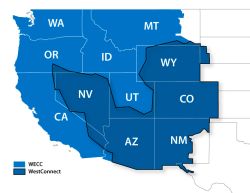 Today, GE Energy has released “The Western Wind & Solar Integration Study,” which was prepared for the National Renewable Energy Laboratory (NREL). The purpose of the report was to investigate the operational impacts and economics of wind, photovoltaics and concentrating solar on the power system operated by the WestConnect group of utilities located mainly in the southwest. The study specifically looked at the benefits and challenges of integrating up to 35 percent wind and solar energy by 2017.
Today, GE Energy has released “The Western Wind & Solar Integration Study,” which was prepared for the National Renewable Energy Laboratory (NREL). The purpose of the report was to investigate the operational impacts and economics of wind, photovoltaics and concentrating solar on the power system operated by the WestConnect group of utilities located mainly in the southwest. The study specifically looked at the benefits and challenges of integrating up to 35 percent wind and solar energy by 2017.
The states involved in WestConnect include Nevada, Arizona, New Mexico, Colorado, and Wyoming and four of these five states currently have Renewable Portfolio Standards (RPS) that require 15-30 percent of the states yearly electricity output to come from renewable energy between 2020-2025.
Among the key findings the study found that:
- 1. Fuel and emission costs decrease as more wind and solar are added. Using 35 percent wind/solar will decrease fuel costs by 40 percent and carbon emissions by 25-45 percent by 2017, depending on the price of natural gas. This is the equivalent of removing 22-36 millions cars from the road.
- 2. CO2 emissions decrease as more wind and solar are added and the emission reductions are even greater if coal is displaced.
It was also discovered that integrating large amounts of wind and solar into the grid does not require extensive additional infrastructure if key changes are made to current operational practice. In addition, increasing the size of the geographic area over which the wind and solar resources are drawn substantially helps to reduce the variability of the resources as does using wind and solar forecasts. The report also noted, as many key wind and energy experts have been saying, that efficiency upgrades will need to be made as well as additional transmission capabilities will need happen in order to realize the full potential of wind and solar energy.
“If key changes can be made to standard operating procedures, our research shows that large amounts of wind and solar can be incorporated onto the grid without a lot of backup generation,” said Dr. Debra Law, NREL project manager for the study. “When you coordinate the operations between utilities across a large geographical area, you decrease the effect of the variability of wind and solar energy sources, mitigating the predictability of Mother Nature.”
You can download a copy of the report here.

